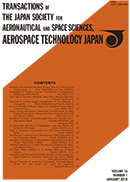18 巻, 4 号
選択された号の論文の4件中1~4を表示しています
- |<
- <
- 1
- >
- >|
論文
-
原稿種別: Full Article
専門分野: Avionics & Systems
2020 年 18 巻 4 号 p. 123-132
発行日: 2020年
公開日: 2020/07/04
PDF形式でダウンロード (2646K) -
原稿種別: Full Article
専門分野: Aerodynamics
2020 年 18 巻 4 号 p. 133-139
発行日: 2020年
公開日: 2020/07/04
PDF形式でダウンロード (868K) -
原稿種別: Full Article
専門分野: Aerospace Propulsion
2020 年 18 巻 4 号 p. 141-148
発行日: 2020年
公開日: 2020/07/04
PDF形式でダウンロード (1922K) -
原稿種別: Full Article
専門分野: Aerodynamics
2020 年 18 巻 4 号 p. 149-158
発行日: 2020年
公開日: 2020/07/04
PDF形式でダウンロード (2493K)
- |<
- <
- 1
- >
- >|
